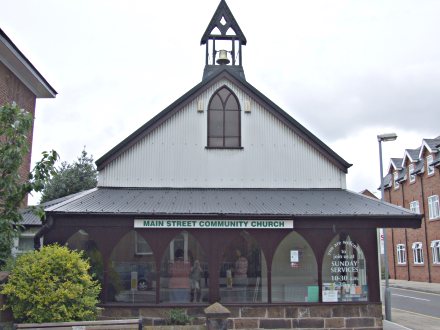 Main Street Community Church, July 2007
Main Street Community Church, July 2007
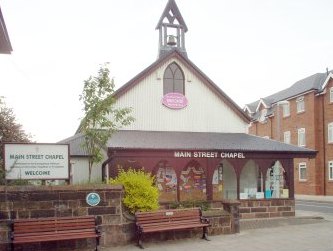 Main Street Chapel,
June 2004
Main Street Chapel,
June 2004
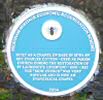 Click on this picture if you want to see a one with larger writing.
Click on this picture if you want to see a one with larger writing.
History of Main Street Community Church
During 2001 a group from Main Street Community Church decided to look into the mystery of the origins of the building the fellowship meets in and, more generally, the history of the Church in Frodsham. It is wonderful to discover how the work of the Lord has evolved here in the building now called Main Street Community Church.
Do let us know if you have any historical information related to St Dunstan’s, the Iron Church, Main Street Chapel or Main Street Community Church.
Stories from the history
Every two months Main Street Community Church publishes a congregational magazine. From 2002 to 2004 it often included an article about the past history of the church, its people and Christian life in Frodsham. Entitled Mystery Slot these reports have been collected together here:
Tin tabernacles
For more general information about “Tin Tabernacles” see the Tin Tabernacles web site. The site features a photograph of Main Street Chapel, Frodsham.
The beginnings …
In early 1872 the vicar of Frodsham, the Reverend William Charles Cotton, proposed building a chapel of ease on the Main Street of Frodsham at an estimated cost of £600 plus £200 for heating, lighting and furniture. The land was provided by the Marquis of Cholmondeley. The building was erected from a kit and opened for Easter Week 1872 [1]. It was named St Dunstan’s.
1880 to 1925
The parish church of St Laurence was temporarily closed for restoration from 28 June 1880. Until 18 May 1883 the Iron Church, as it was also known, was fully licensed as the main parish church. The vicar in 1880 was the Reverend Henry Birdwood Blogg. The parish church at St Laurence’s re-opened on St Andrew’s day, 30 November 1882. [2]
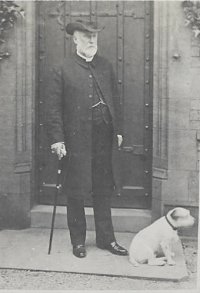 The Reverend H B Blogg, vicar of Frodsham 1879 to 1911.
The Reverend H B Blogg, vicar of Frodsham 1879 to 1911.
St Dunstan’s is listed in the 1892 edition of Kelly’s Directory as “The Mission church, Main street, is an iron building, and is served from the mother church at Overton: there are 230 sittings.” By the 1906 edition there was another Mission church, at Frodsham Bridge, and the entry became “The church of St. Dunstan, in Main street, an iron building, affords 230 sittings, and is served from the mother church at Overton.”
We collected some extracts from the Frodsham Parish Magazines for these years.
The 1930s and 1940s
We collected extracts from old newspapers from the period which mention St Dunstan’s:
The photograph below was taken at Evensong at St Dunstan’s.
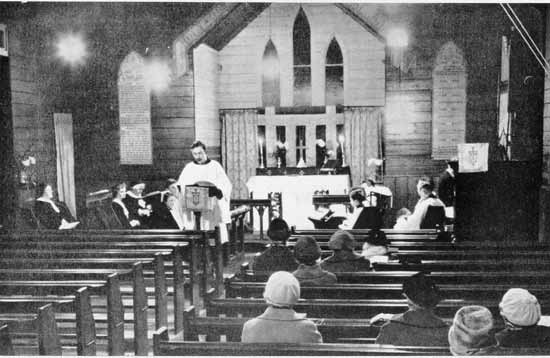
A new start
After some years of disuse, the building was taken over by Frodsham Evangelical Fellowship. This group had been meeting at the Frodsham Community Centre on Sunday mornings. The building was refurbished and it reopened as a place of worship at the start of the 1980s.
1995 … On the move
The trustees of Frodsham Evangelical Fellowship sold some land at the back of the church building to allow a developer to build a nursing home. To make room for the road needed to access to nursing home the church building had to move. It was put on rollers and taken ten feet to the left! [3] At the same time a new worship area was built onto the back of the building and the whole building extensively refurbished.
2007 … A new name
On 1 July 2007 the congregation was re-named as Main Street Community Church and the building name changed accordingly. The website moved from mainstreetchapel.org.uk to MSCCh.org but most of the old content was retained. The old domain name continues to work.
The future …
It really does make you think just what the next 10 or 15 years might bring. Exciting isn’t it?!
Why look at the history?
Overall, one gets the impression that church life was not quite so different from today as we might think. But things did not carry on for ever as they were, they had to adapt into what we have today. Maybe this history has some lessons for us for our future.
The Bible is a powerful witness to the importance of history, to the importance of remembering what God has done for his people over the years. When we look back at the history of the church we can be encouraged where we see God’s hand working through the centuries and warned as we see his people make mistakes. As someone once said, there is nothing new under the sun.
Acknowledgements
Thanks to Judith Shore and to Dr Andrew Faraday for most of the material on these pages about the history of St Dunstan’s. Thanks to Dilys for the photograph of Evensong. Have you anything to contribute to it? Please send an email.
References
1. A R Smith, William Charles Cotton MA 1813–1879 Priest, Missionary and Bee Master: A turbulent life. Countrywise, Birkenhead, England. 2006. pp 181 and 182.
2. Frodsham and Manley Parish Magazine, February 1883.
3. Photograph and report in the Liverpool Daily Post, 9 August 1995.
